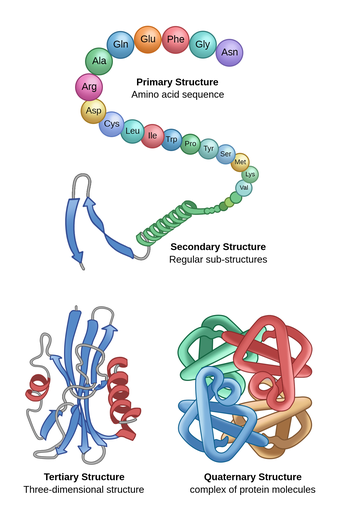Miriam Martínez - 05 December 2022
The central dogma of molecular biology
What is the relationship between DNA, RNA, and proteins?

In this post we will talk about how genes direct the production of proteins. The flow of information from DNA to RNA to proteins is one of the fundamental principles of molecular biology. It is so important that it is usually called the “central dogma".
The DNA
The DNA (Deoxyribonucleic acid) is the molecule in which all organisms store their genetic information. Think of DNA as the instructions manual for an organism. It can be found in the nucleus of all cells of an organism, compacted into structures known as chromosomes.
It is a polymer composed by two complementary chains of monomeric units (nucleotides) that form a double helix. Four types of nucleotides can be found in a DNA sequence: Adenine (A), Thymine (T), Cytosine (C), Guanine (G).
The information carried by DNA molecules is organized in different blocks known as genes. A gene is a portion of DNA that represents the basic unit of biological inheritance (the process that allows the passing of a trait from parents to offspring).
 DNA structure and composition. Source: Shutterstock Soleil Nordic.
DNA structure and composition. Source: Shutterstock Soleil Nordic.
The protein
The duties specified in the genetic information are performed by proteins.
Proteins are polymeric macromolecules responsible for a vast array of functions, including catalyzing metabolic reactions, responding to stimuli, providing structure to cells and organisms, and transporting molecules from one location to another.
Proteins are composed by a linear chain of amino acids (whose sequence is defined by the nucleotide sequence of the corresponding gene). 20 different amino acids have been described in the sequence of proteins. The various structures and conformation formed by amino acids and proteins are given specific terms.
 Protein structure and composition. Source: Theory.Labster.com
Protein structure and composition. Source: Theory.Labster.com
The primary structure refers to the linear amino acid sequence.
The secondary structure refers to the formation of regular substructures such as alpha helices or beta sheets.
The tertiary structure describes the 3D structure of the protein, accounting for the way the substructures interact with each other.
Finally, if a protein is comprised of multiple polypeptides, their interaction is described in the quaternary structure.
The RNA
To be transferred from genes to proteins, the genetic information is transmitted to an intermediary molecule: the RNA (Ribonucleic acid).
The RNA is a polymer composed by a single chain of nucleotides. Four types of nucleotides can be found in a RNA sequence: Adenine (A), Uracil (U), Cytosine (C), Guanine (G).
Three types of RNA are necessary to synthetize a protein:
- Messenger RNA (mRNA): containing the genetic information encoding for the amino acid sequence of a protein.
- Transfer RNA (tRNA): matching different amino acids to the corresponding mRNA sequences.
- Ribosomal RNA (rRNA): making up the ribosomes (the organelles in which protein synthesis occurs).
 Types of RNA and their respective functions. Source: Medbullets.com
Types of RNA and their respective functions. Source: Medbullets.com
The central dogma of molecular biology

This flow can be simplified as following:
- DNA can be copied to DNA (DNA replication): this process occurs during cell divisions and allows to pass the genetic information from a mother to a daughter cell.
- DNA can be copied to RNA (RNA transcription): this is the first step of the gene expression process. mRNA molecules are responsible for the transfer of the genetic information from the nucleus (where the information is stored) to the cytoplasm (where protein synthesis occurs).
- RNA can be used as a template to synthetize proteins (protein translation): this is the final step of the gene expression process. The ribosome, a specialized complex that "reads" the sequence of mRNA nucleotides, interacts with the mRNA. Each sequence of three nucleotides, called a codon, typically codes for one specific amino acid. The protein is assembled one amino acid at a time by tRNA. Protein assembly continues until the ribosome encounters a “stop” codon (a sequence of three nucleotides that does not code for an amino acid).
 By Miriam Martínez
By Miriam Martínez
Miriam is a Human Biologist expert in neuropharmacology. After a master’s degree in Pharmaceutical and Biotech Industry, she obtained her PhD in Biomedicine from Pompeu Fabra University (Barcelona). During her doctorate, she focused her research on the behavioral analysis of animal models for neurophenotypical characterization. Since then, she has been working in the healthcare marketing and publicity sector, where she has contributed to developing marketing campaigns for several pharmaceutical brands. In 2021, she joined ZeClinics with a branding and marketing strategy focus.